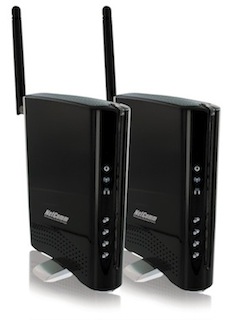
It wasn't that long ago that in order to connect a computer to the internet you needed to either have a telephone socket somewhere nearby, or be willing to run cable throughout your house. Not only has wireless internet helped do away with the tangle of cables, but it's also paved the way for many other things - like being able to connect smartphones to your home internet, or to stream high definition movies or music to anywhere in the house.
There's a problem, though - wireless routers have a limited range, and in some cases the way your house is laid out may affect how well your WiFi works.
What is the 'average' range of a wireless router or access point?
A lot of manufacturers make bold claims about the range of their wireless routers. The truth is that in the real world, your WiFi probably won't reach as far as it's theoretically able to. The 'average' 802.11b or 802.11g router will do a good job of providing coverage for a 'normal' three bedroom home over a standard quarter acre block. 802.11n routers use different antenna technology, and depending on the circumstances, may even offer twice as much reach.
There are all sorts of things that can have a very big effect on how far your WiFi is able to reach though - and in some cases, you mightn't even be able to access a router that's sitting in the next room.
What affects wireless range?
There are a number of things that will affect the range of your wireless network. These include:
Walls, floors/ceilings
Other wireless networks - WiFi networks all work at around the same frequency, but can be set to different 'channels'. If there's another network nearby (especially one that's operating on the same channel or a nearby channel), it may have a big impact on your signal. The easy solution to this is to log into your router and change the channel it broadcasts on. If possible, try and choose a channel that's at least 5 channels away from any other networks in your area. For example, if your neighbours are using channel 6, set yours to either 1 or 12.
Other appliances and devices - WiFi uses the 2.4GHz (or 'microwave') band to communicate. The problem with this is that there are a lot of other devices that operate around this frequency too, and they can all seriously interfere with your WiFi signal. Microwave ovens, cordless telephones, MP3 players, Bluetooth devices, ZigBee devices, baby monitors, proprietary security systems and countless other things can all negatively affect your signal.
How can I increase my WiFi range?
If you need extra range because you have a big home or because you're limited in where you're able to put your wireless router, don't give up - you still have options! Below are some of the ways that you can improve your WiFi range:
Move other appliances around - If a microwave or cordless phone is interfering with your signal, moving other appliances around may help to improve the signal.
Bigger antennas - It's possible to replace the small WiFi antennas that came with your router for bigger, long-range antennas. Keep in mind that by doing so, you may also be inadvertently be affecting your neighbours' signals. These are normally available fairly cheaply at an electronics store - just make sure you get one with the same sized screw thread.
Add another access point - Some routers can be coupled with other routers to create what's called a 'mesh network'. This works by wirelessly connecting the two (or more) routers so that they work to create one big network, effectively expanding the size of the area your network covers. In most cases, you will need to check to ensure that your router is able to support this feature, and make sure you're trying to connect to a compatible router. A mesh network is a very effective way of ensuring a good signal throughout a big home.

